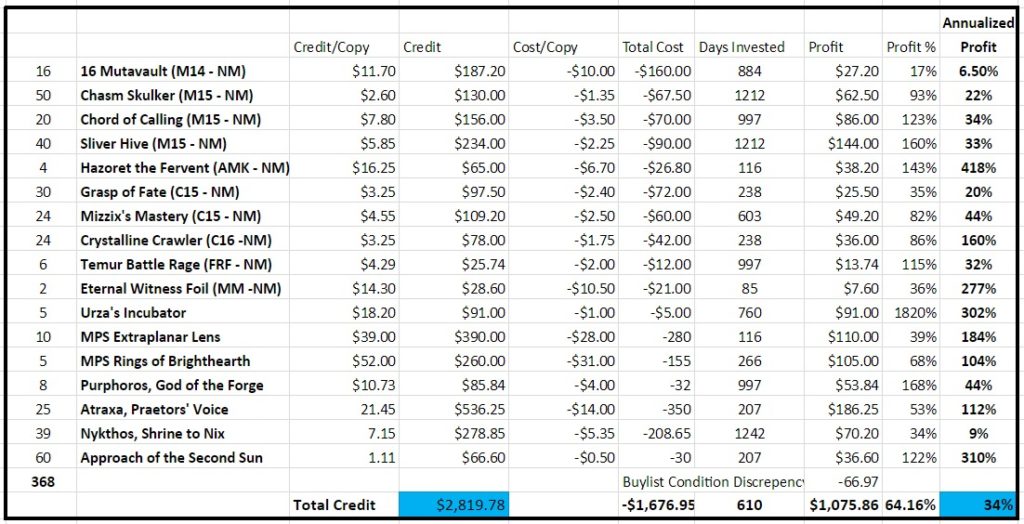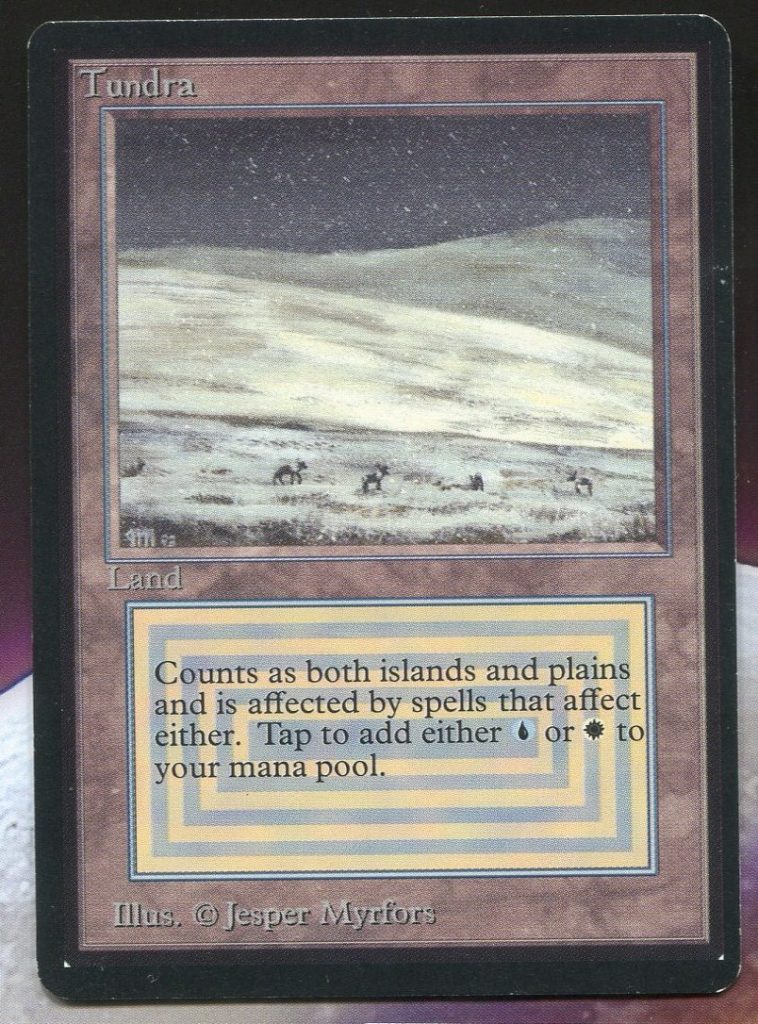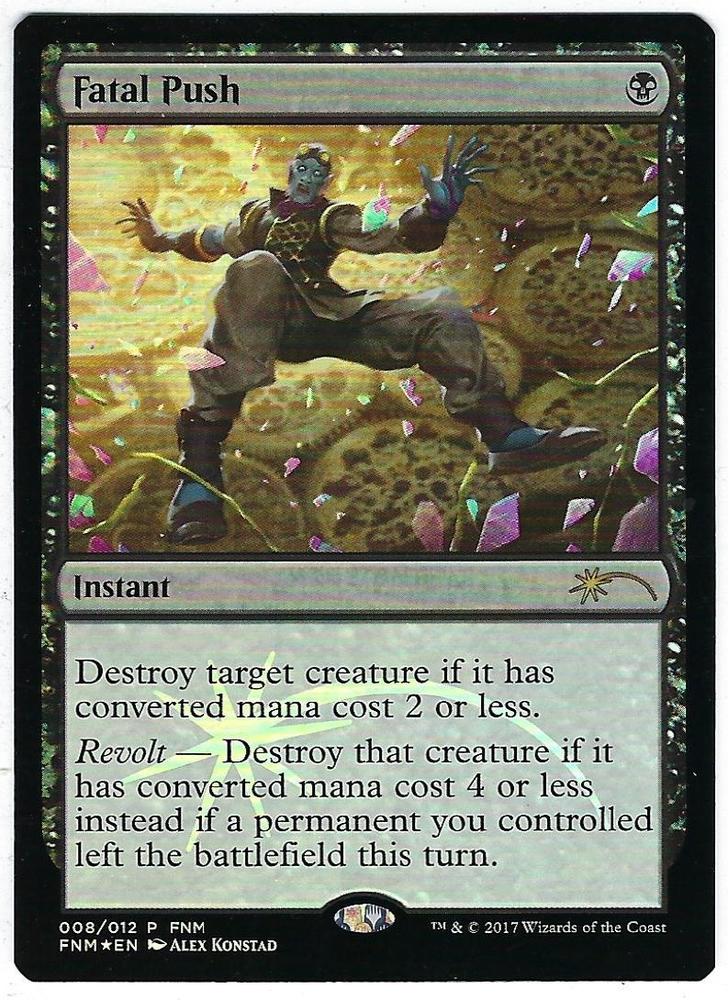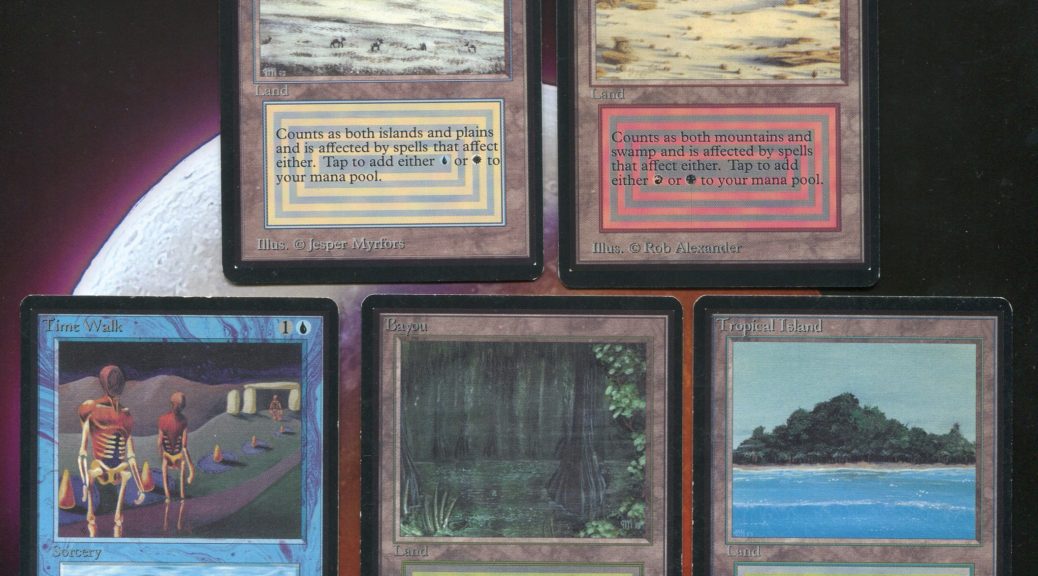Buylists aren’t generally my thing. In my mind selling to a buylist often feels like admitting a mistake. If I bought in a card at $10, why should I sell it to a buylist for $12-14 if the going market rate is $20, and I can still get over $16 after fees and shipping? Most of the time I’m aiming for specs to succeed at a level where selling them less than 5% below the lowest TCG NM price is a legitimate option. If I bought Masterpiece Sol Rings in Europe last winter for $72 by the dozen, I really want my exit to as close to $200 as possible, and generally, by selecting the right specs and being reasonably patient these goals are achieved.
The thing is, if you’re really deep on a card, and they’re selling ok, but tend to sell slowly, AND you have solid leads on better specs, turning over your inventory to set up your superior reinvestment is still worth a look.
At present, my goal for MTGFinance speculation is a return on investment in excess of 50% per annum. For 2017, I’m currently on track to beat 65%, but aiming lower is safer for planning purposes.
If you’re used to traditional methods of investing this will seem like a fairly ambitious target, but if you’ve got some money tied up in Bitcoin (up over 800% in the last year!), you’ll probably stop reading at this point and go back to planning your vacation home.
In 2017, based on my reasonable success over the last couple of years, I’ve ramped up my MTGFinance investments to 30% of what I invest overall in a given year across all assets. The collection, and my hobby, is now utterly self sufficient and detached from my wallet, meaning that I am reinvesting everything I make back into the hobby without the need to extract any funds to cover bills and such, or add any funds to invest or play.
That being said, in MTGFinanace, as with most investments, the elimination of error and risk is virtually impossible. You can’t rely on winning all the time, so you need to dodge your worst possible outcomes by adjusting how deep you go based on your confidence level as informed by your spec selection logic. You can read more about rating specs over here.
In essence, you know that some reasonable % of your specs are going to fail to stay flat or even lose value, so you need to ensure that the ones that succeed, do so at levels far above your average stock portfolio. In short, your wins need to cover your losses AND provide your profits. When you’re starting out, you’re going to make plenty of mistakes. My specs are stored organized by date of purchase, and the quality of specs in 2017 is significantly better than from 2015 or 2013 tracking directly with my accumulation of knowledge, contacts, practice and lessons learned the hard way.
For those of us who have a closet or shelf dedicated to our specs, there is inevitably a box of shame in the mix. For me, there are a couple of under-performing long boxes, including a mixture of long shot specs that still haven’t hit a few years later, cards that have done well, but that are slow to sell or that sell one at a time (usually because they are EDH cards), and some cards that haven’t moved much since I invested but seem at an unreasonably high risk of reprint and are likely safer to exit from.
So a few weeks back I got curious: if I got my hands dirty in the back of my spec closet, could I mine untapped value and turn some of my least impressive specs into something special via a large buylist order. Because I’m in Canada, tracked shipping that would meet the buylist requirements to have my cards arrive within about a week was going to be about $20USD, so I resolved to attempt to pull together a $1000+ order than would diffuse that cost almost entirely.
Recalling that CardKindom and MTGDeals were often two of the more aggressive buylists recommended by my peers, I spent 30 minutes or so quickly price checking 40-50 cards that met at least one of the following criteria:
- low on my priority list to post for sale if not yet posted (only a fraction of my specs are posted for sale at any given time, as I only have 5-10 hours/week to spend on this aspect of the hobby)
- higher than average risk of reprint in 2017-2018
- solid gains, but slow to move
- higher than average buylist offers vs. retail price
- recently peaking but at risk of retracing to a lower price plateau
I also cross referenced against recent price trends and likely alternate sale prices and pace on TCGPlayer.com and Ebay.
Here’s what I ended up pulling out of the closet and shipping to Card Kingdom after they end up proving out to have the best offer on my cards:

Let’s take a closer look at what I sent in here.
Mutavault, Chord of Calling, Nykthos, Shrine to Nix, and Temur Battle Rage foils were specs I went fairly deep on when they hit their lows, but which I was selling out of too slowly for my liking. Mutavault seemed especially likely to see a reprint in a tribal heavy year of releases, and I was fortunate to exit when I did given the sweet GP Promo version that was announced shortly after I sent in my order.
Many of the others, including Chasm Skulker, Grasp of Fate, Mizzix’s Mastery, Crystalline Crawler, Urza’s Incubator and the Masterpiece Extraplanar Lens and Rings of Brighthearth were solid EDH specs that carry the disadvantage of selling a copy at a time if they aren’t buylisted. For cards that I get really low, that later climb above $10, I don’t mind terribly shipping them out in a plain white envelope with a $1 stamp, but loading them into a $3k buylist order saves me a couple of hundred dollars total in shipping, as well as the time I would have spent packaging them and mailing them individually. That’s a nice piece of shadow profit to hold against the below market revenues from the buylist.
Atraxa, Praetor’s Voice was one of my first forays into targeting popular commanders, and it was clearly a successful one. However, I fully expect this card to show up as a judge promo foil or something in the next couple of years, and the margin here was good enough to dodge that risk entirely on the fairly sizeable number of remaining copies I was holding, give the pace of EDH staple sales, and the fact that Atraxa is no longer the flavor of the month after the recent Commander 2017 releases and the constant stream of interesting new commanders in Standard legal sets.
The Urza’s Incubators were just lying around in the “Super Collection” I bought in the summer of 2015, and since that project was already wildly profitable and all expenses were covered by it’s resale in Dec 2015, anything I find in the leftovers these days I just assign a nominal cost to in my sales records so as not to throw the profit figures too far out of whack.
Approach of the Second Sun has an uncertain future in Standard, so profit taking there on my remaining sixty copies seemed like a solid move given that the first forty copies I sold on Ebay had already made the spec from last spring worthwhile. Ditching my last playset of Hazoret may have been premature, since that deck doesn’t seem to be going anywhere but I reasoned that if the meta stays narrow at and after Pro Tour Ixalan, people may end up less interested in Standard and profit taking this winter may get tricky. Potentially better to be out clean on a one trick pony, with one fewer spec to track.
All in all, very few of these cards were things I felt deserved my attention as priority specs in the current context and the opportunity to turn over these dead ends/time intensive exits in one fell swoop was too good to ignore. Not needing any of them for my own decks was a solid kicker.
By the numbers, this was 17 different cards spread across a total of 368 total copies. My original cost on the pile was $1676.95, and I expected to receive very close to the promised $2820USD after inspection by Card Kingdom as I hold myself to strict grading under strong light. In the end, I did get dinger on a few cards in the order, but the total reduction was less than 2% and I ended up with $2752 in store credit. Had I taken cash it would have been 30% less. Generally speaking, since I am always buying specs, I am happy to take the credit bonus from any major retailer knowing that they will have inventory I want soon enough. If I was selling to a smaller operator however, that might not have suitable targets or not have them all that often, I would almost certainly take the cash.
All told, I held these specs for an average of 610 days, or a few months less than two years. This is by no means my usual target exit horizon of three to twelve months, but that’s to be expected for a pile of cards that I was largely ignoring at the back of the spec closet and the key reason I decided to try and exit on some of them in the first place. Surprisingly, the total profit was still a shade over 64%, though only 34% when I annualized those returns. Even still, 34% is a pretty good year for traditional investments by any reasonable measure, and if you could repeat that annually across your entire portfolio you wouldn’t have any reason to be upset. On the bulk of my Magic portfolio I do significantly better, but some quick math tells me that the profit this exit has easily covered off the cost of the truly terrible specs (ahem Aggressive Mining) that are still stuck in the box of shame, and then some.
Overall, that’s a good place to be, but tallying your buylist success you also have to assume that the total profit will be further reduced by at least 15%, since I took credit instead of cash and still need to sell the cards I acquire with that credit to achieve net profits.
So now that I’ve got a solid exit on a piece of my portfolio what’s the next move to be made with $2800 in store credit at CardKingdom.com?
What I’m Buying & Why
One of my goals with MTGFinance is to occasionally take lesser profit to facilitate some of my relatively infrequent treasure hunts as a collector. I would eventually like to trade my way into a Beta set of Power 9 + 4x Dual Lands, and I’d like to do it within the next five years.
Now I should point out that I don’t actually believe that the Power 9/Reserved List/Beta Duals are priority specs. Rather, I see them as excellent value stores that tend to trend up modestly and almost never trend down. I don’t expect more than 10%/annum returns on this stuff, but they also don’t carry any significant reprint risk. Even still, tying up funds that you could be cycling into spec after spec every 3-6 months, into a single card that will grow more slowly and without compounding, is not the smartest move.
There is however an additional mitigating factor in play for me: time. I don’t have enough time to sell my succesful specs in a timely fashion as is. In any given week there are likely 50 Ebay listings I should be getting up, and I’m only getting through half of them. Some of them will only appreciate further while negligence substitutes for patience, but others will rot on the vine. I’ve got a new baby, we’re running two businesses and my hourly rate is too high to substitute this action for real work time. If you’ve got a full time job and a family, I’m sure you understand.
So the time constraint changes the math. I’m already maxing on research, spec purchasing and spec sales time, so pushing some value out of the shame box and into a single high value target that is liquid enough to be resold or traded up into lower value specs with a strong margin once I’ve cleared the back log holds serious appeal.
So with my $2800 in credit on deck, a quick review of the Card Kingdom inventory lead me to this beauty:

Hello Beta Tundra! Card Kingdom called this thing Near Mint, and was asking $2499. The back right edge has some solid wear however, and you can likely parse the minor marks on the front right, so I place this thing at a solid LP. It’s not perfect, but this is still a lovely Magic card and they’re really aren’t that many out there for sale online at any price. If Magic does well over the next 3-5 years, this card might hit $3000, but it’s true street price might be closer to $2000-$2200 at present so I’m taking a bit of a hit there by accepting the stated grade. If Magic only does ok, which is the more likely outcome, my value is unlikely to erode and I can almost certainly recover the loss from inaccurate grading via a trade down into higher priority spec targets whenever I like. A move into newly released and under-priced Masterpieces or judge promo foils at some point would be a likely option.

The remaining credit I pushed into 20 copies of the FNM Promo Fatal Push at $12.99. This was one of the specs I called out on MTGFastFinance this week, and though my preferred entry at present is closer to $10, the reality is that I think these will hit $30 within 12-18 months and I’m happy getting in on as many as I can under $15. Fatal Push is going to get reprinted a few times in the next five years, but aside from the inevitable Masterpiece Series, I expect the FNM promos to hit at least half the price of the pack foils as the art on these is arguably superior.
I hope you’ve enjoyed this walk through of a large buylist order aimed at reducing inventory, consolidating profit and fulfilling my collector goals. Join me next week when I take you on a tour of the worst specs I’ve ever purchased.
James Chillcott (@mtgcritic) is an entrepreneur, investor, designer, collector, gamer and adventurer. Between dolling out good advice and humble bragging on Twitter he can be found playing with his daughter Alara, running a couple of web companies and eating cookies.

Good article, thanks for putting this together.